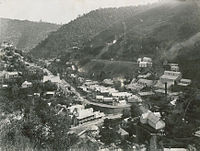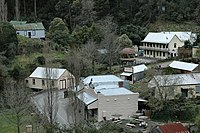Ghost town


A ghost town is an abandoned village, town, or city, usually one that contains substantial visible remains. A town often becomes a ghost town because the economic activity that supported it has failed, or due to natural or human-caused disasters such as floods, government actions, uncontrolled lawlessness, war, or nuclear disasters. The term can sometimes refer to cities, towns, and neighborhoods that are still populated, but significantly less so than in years past; for example those affected by high levels of unemployment and dereliction.[1]
Some ghost towns, especially those that preserve period-specific architecture, have become tourist attractions. Some examples are Bannack, Montana; Calico, California; Centralia, Pennsylvania; Oatman, Arizona; and South Pass City, Wyoming in the United States; Barkerville, British Columbia in Canada; Craco in Italy; Elizabeth Bay and Kolmanskop in Namibia; Pripyat in Ukraine; and Danushkodi in India. Visiting, writing about, and photographing ghost towns is a minor industry.
The town of Plymouth on the Caribbean island of Montserrat is a ghost town that is the de jure capital of Montserrat.
Definition
The definition of a ghost town varies between individuals, and between cultures. Some writers discount settlements that were abandoned as a result of a natural or human-made disaster or other causes using the term only to describe settlements that were deserted because they were no longer economically viable; T. Lindsey Baker, author of Ghost Towns of Texas, defines a ghost town as "a town for which the reason for being no longer exists".[1] Some believe that any settlement with visible tangible remains should not be called a ghost town;[2] others say, conversely, that a ghost town should contain the tangible remains of buildings.[3] Whether or not the settlement must be completely deserted, or may contain a small population, is also a matter for debate.[2] Generally, though, the term is used in a looser sense, encompassing any and all of these definitions. The American author Lambert Florin's preferred definition of a ghost town was simply "a shadowy semblance of a former self".[4]
Reasons for abandonment
Factors leading to abandonment of towns include depleted natural resources, economic activity shifting elsewhere, railroads and roads bypassing or no longer accessing the town, human intervention, disasters, massacres, wars, and the shifting of politics or fall of empires.[5] A town can also be abandoned when it is part of an exclusion zone due to natural or man-made causes.
Economic activity shifting elsewhere
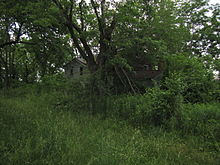
Ghost towns may result when the single activity or resource that created a boomtown (e.g., nearby mine, mill or resort) is depleted or the resource economy undergoes a "bust" (e.g., catastrophic resource price collapse). Boomtowns can often decrease in size as fast as they initially grew. Sometimes, all or nearly the entire population can desert the town, resulting in a ghost town.
The dismantling of a boomtown can often occur on a planned basis. Mining companies nowadays will create a temporary community to service a mine site, building all the accommodation shops and services required, and then removing them once the resource has been extracted. Modular buildings can be used to facilitate the process. A gold rush would often bring intensive but short-lived economic activity to a remote village, only to leave a ghost town once the resource was depleted.
In some cases, multiple factors may remove the economic basis for a community; some former mining towns on U.S. Route 66 suffered both mine closures when the resources were depleted and loss of highway traffic as US 66 was diverted away from places like Oatman, Arizona onto a more direct path.
In other cases, the reason for abandonment can arise from a town's intended economic function shifting to another, nearby place. This happened to Collingwood, Queensland in Outback Australia when nearby Winton outperformed Collingwood as a regional centre for the livestock-raising industry. The railway reached Winton in 1899, linking it with the rest of Queensland, and Collingwood was a ghost town by the following year.
The Middle East has many ghost towns that were created when the shifting of politics or the fall of empires caused capital cities to be socially or economically unviable, such as Ctesiphon.
The rise of condominium investment caused for real estate bubbles also leads to a ghost town, as real estate prices rise and affordable housing becomes less available. Such examples include China and Canada, where housing is often used as an investment rather than for habitation.
Human intervention

Railroads and roads bypassing or no longer reaching a town can create a ghost town. This was the case in many of the ghost towns along Ontario's historic Opeongo Line, and along U.S. Route 66 after motorists bypassed the latter on the faster moving highways I-44 and I-40. Some ghost towns were originally founded along railways where steam trains would stop at periodic intervals to take on water. Amboy, California was part of one such series of villages along the Atlantic and Pacific Railroad across the Mojave Desert.
River re-routing is another factor, one example being the towns along the Aral Sea.
Ghost towns may be created when land is expropriated by a government and residents are required to relocate. One example is the village of Tyneham in Dorset, England, acquired during World War II to build an artillery range.
A similar situation occurred in the U.S. when NASA acquired land to construct the John C. Stennis Space Center (SSC), a rocket testing facility in Hancock County, Mississippi (on the Mississippi side of the Pearl River, which is the Mississippi–Louisiana state line). This required NASA to acquire a large (approximately 34-square-mile (88 km2)) buffer zone because of the loud noise and potential dangers associated with testing such rockets. Five thinly populated rural Mississippi communities (Gainesville, Logtown, Napoleon, Santa Rosa, and Westonia), plus the northern portion of a sixth (Pearlington), along with 700 families in residence, had to be completely relocated off the facility.
Sometimes the town might cease to officially exist, but the physical infrastructure remains. For example, the five Mississippi communities that had to be abandoned to build SSC still have remnants of those communities within the facility itself. These include city streets, now overgrown with forest flora and fauna, and a one-room school house. Another example of infrastructure remaining is the former town of Weston, Illinois, that voted itself out of existence and turned the land over for construction of the Fermi National Accelerator Laboratory. Many houses and even a few barns remain, used for housing visiting scientists and storing maintenance equipment, while roads that used to cross through the site have been blocked off at the edges of the property, with gatehouses or simply barricades to prevent unsupervised access.
Flooding by dams
Construction of dams has produced ghost towns that have been left underwater. Examples include the settlement of Loyston, Tennessee, U.S., inundated by the creation of Norris Dam. The town was reorganised and reconstructed on nearby higher ground. Other examples are The Lost Villages of Ontario flooded by Saint Lawrence Seaway construction in 1958, the hamlets of Nether Hambleton and Middle Hambleton in Rutland, England, which were flooded to create Rutland Water, and the villages of Ashopton and Derwent, England, flooded during the construction of the Ladybower Reservoir. Mologa in Russia was flooded by the creation of Rybinsk reservoir, and in France the Tignes Dam flooded the village of Tignes, displacing 78 families. Many ancient villages had to be abandoned during construction of the Three Gorges Dam in China, leading to displacement of many rural people. In the Costa Rican province of Guanacaste, the town of Arenal was rebuilt to make room for the man-made Lake Arenal. The old town now lies submerged below the lake. Old Adaminaby was flooded by a dam of the Snowy River Scheme. Construction of the Aswan High Dam on the Nile River in Egypt submerged archaeological sites and ancient settlements such as Buhen under Lake Nasser.
Massacres
Some towns become deserted when their populations are massacred. The original French village at Oradour-sur-Glane was destroyed on 10 June 1944 when 642 of its 663 inhabitants, including women and children, were killed by a German Waffen-SS company. A new village was built after the war on a nearby site, and the ruins of the original have been maintained as a memorial.
Disasters, actual and anticipated

Natural and man-made disasters can create ghost towns. For example, after being flooded more than 30 times since their town was founded in 1845, residents of Pattonsburg, Missouri, decided to relocate after two floods in 1993. With government help, the whole town was rebuilt 3 miles (4.8 km) away.
Craco, a medieval village in the Italian region of Basilicata, was evacuated after a landslide in 1963. Nowadays it is a famous filming location for many movies, including The Passion of The Christ by Mel Gibson, Christ Stopped at Eboli by Francesco Rosi, The Nativity Story by Catherine Hardwicke and Quantum of Solace by Marc Forster.[6]
In 1984, Centralia, Pennsylvania was abandoned due to an uncontainable mine fire, which began in 1962 and still rages to this day; eventually the fire reached an abandoned mine underneath the nearby town of Byrnesville, Pennsylvania, which caused that mine to catch on fire too and forced the evacuation of that town as well.
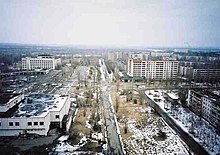
Ghost towns may also occasionally come into being due to an anticipated natural disaster – for example, the Canadian town of Lemieux, Ontario was abandoned in 1991 after soil testing revealed that the community was built on an unstable bed of Leda clay. Two years after the last building in Lemieux was demolished, a landslide swept part of the former town-site into the South Nation River. Two decades earlier, the Canadian town of Saint-Jean-Vianney, Québec, also constructed on a Leda clay base, had been abandoned after a landslide on 4 May 1971, which swept away 41 homes, killing 31 people.
Following the Chernobyl disaster of 1986, dangerously high levels of nuclear radiation escaped into the surrounding area, and nearly 200 towns and villages in Ukraine and neighbouring Belarus were evacuated, including the cities of Pripyat and Chernobyl. The area was, and still is, so contaminated with nuclear radiation that many of the evacuees were never permitted to return to their homes. Pripyat is the most famous of these abandoned towns; it was built for the workers of the Chernobyl Nuclear Power Plant and had a population of almost 50,000 at the time of the disaster.[7]
Disease and contamination
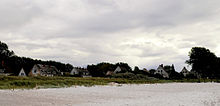
Significant fatality rates from epidemics have produced ghost towns. Some places in eastern Arkansas were abandoned after more than 7,000 Arkansans died during the Spanish Flu epidemic of 1918 and 1919.[8][9] Several communities in Ireland, particularly in the west of the country, were wiped out due to the Great Famine in the latter half of the 19th century, and the years of economic decline that followed.
Catastrophic environmental damage caused by long-term contamination can also create a ghost town. Some notable examples are Times Beach, Missouri, whose residents were exposed to a high level of dioxins, and Wittenoom, Western Australia, which was once Australia's largest source of blue asbestos, but was shut down in 1966 due to health concerns. Treece and Picher, twin communities straddling the Kansas–Oklahoma border, were once one of the United States' largest sources of zinc and lead, but over a century of unregulated disposal of mine tailings led to groundwater contamination and lead poisoning in the town's children, eventually resulting in a mandatory Environmental Protection Agency buyout and evacuation. Contamination due to ammunition caused by military use may also lead to the development of ghost towns.
Revived ghost towns
This section needs additional citations for verification. (September 2012) |
A few ghost towns get a second life, often due to heritage tourism generating a new economy able to support residents. For example, Walhalla, Victoria, Australia, became almost deserted[10] after its gold mine ceased operation in 1914, but owing to its accessibility and proximity to other attractive locations it has had a recent economic and holiday population surge.
Alexandria, the second largest city of Egypt, was a flourishing city in the Ancient era, but declined during the Middle Ages. It underwent a dramatic revival during the 19th century; from a population of 5,000 in 1806, it grew into a city of more than 200,000 inhabitants by 1882,[11] and is now home to more than four million people.[12]
In Algeria, many cities became hamlets after the end of Late Antiquity. They were revived with shifts in population during and after French colonization of Algeria. Oran, currently the nation's second largest city with 1 million people, was a village of only a few thousand people before colonization.
Foncebadón, a village in León, Spain that was mostly abandoned and only inhabited by a mother and son, is slowly being revived owing to the ever-increasing stream of pilgrims on the road to Santiago de Compostela.
Around the world
Africa

Wars and rebellions in some African countries have left many towns and villages deserted. Since 2003, when President François Bozizé came to power, thousands of citizens of the Central African Republic have been forced to flee their homes as a result of the escalating conflict between armed rebels and government troops. Villages accused of supporting the rebels, such as Beogombo Deux near Paoua, are ransacked by government soldiers; those who are not killed have no choice but to escape to refugee camps.[13] The instability in the region also leaves organized and well-equipped bandits free to terrorize the populace, often leaving villages abandoned in their wake.[14] Elsewhere in Africa, the town of Lukangol was burnt to the ground during tribal clashes in South Sudan. Before its destruction, the town had a population of 20,000.[15]
Many of the ghost towns in mineral-rich Africa are former mining towns. Shortly after the start of the 1908 diamond rush in German South-West Africa, now known as Namibia, the German Imperial government claimed sole mining rights by creating the Sperrgebiet (forbidden zone),[16] effectively criminalizing new settlement. The small mining towns of this area, among them Pomona, Elizabeth Bay and Kolmanskop, were exempt from this ban, but the denial of new land claims soon rendered all of them ghost towns.
Asia

China has many large urban property developments, sometimes referred to as "ghost cities", that have remained mostly unoccupied since they were built.[17][18]
The town of Dhanushkodi, India is a ghost town.
Many abandoned towns and settlements in the former Soviet Union were established near Gulag concentration camps to supply necessary services. Since most of these camps were abandoned in the 1950s, the towns were abandoned as well. One such town is located near the former Gulag camp called Butugychag (also called Lower Butugychag). Other towns were deserted due to deindustrialisation and the economic crises of the early 1990s attributed to post-Soviet conflicts.
Antarctica

The oldest ghost town in Antarctica is on Deception Island, where in 1906, a Norwegian-Chilean company set up a whaling station at Whalers Bay, which they used as a base for their factory ship, the Gobernador Bories. Other whaling operations followed suit, and by 1914 there were thirteen factory ships based there. The station ceased to be profitable during the Great Depression, and was abandoned in 1931. In 1969, the station was partially destroyed by a volcanic eruption. There are also many abandoned scientific and military bases in Antarctica, especially in the Antarctic Peninsula.
The Antarctic island of South Georgia used to have several thriving whaling settlements during the first half of the 20th century, with a combined population exceeding 2,000 in some years. These included Grytviken (operating 1904-64), Leith Harbour (1909–65), Ocean Harbour (1909–20), Husvik (1910–60), Stromness (1912–61) and Prince Olav Harbour (1917–34). The abandoned settlements have become increasingly dilapidated, and remain uninhabited nowadays except for the Museum curator's family at Grytviken. The jetty, the church, and dwelling and industrial buildings at Grytviken have recently been renovated by the South Georgian Government, becoming a popular tourist destination. Some historical buildings in the other settlements are being restored as well.
Europe
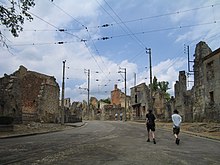
Urbanization – the migration of a country's rural population into the cities – has left many European towns and villages deserted. An increasing number of settlements in Bulgaria are becoming ghost towns for this reason; at the time of the 2011 census, the country had 181 uninhabited settlements.[19] In Hungary, dozens of villages are also threatened with abandonment. The first village officially declared as "dead" was Gyűrűfű in the late 1970s, but later it was repopulated as an eco-village. Some other depopulated villages were successfully saved as small rural resorts, such as Kán, Tornakápolna, Szanticska, Gorica, and Révfalu.
In Spain, large zones of the mountainous Iberian System and the Pyrenees have undergone heavy depopulation since the early 20th century, leaving a string of ghost towns in areas such as the Solana Valley. Traditional agricultural practices such as sheep and goat rearing, on which the mountain village economy was based, were not taken over by the local youth, especially after the lifestyle changes that swept over rural Spain during the second half of the 20th century.[20]
In the United Kingdom, thousands of villages were abandoned during the Middle Ages, as a result of Black Death, climate change, revolts, and enclosure, the process by which vast amounts of farmland became privately owned. Since there are rarely any visible remains of these settlements, they are not generally considered ghost towns; instead, they are referred to in archaeological circles as deserted medieval villages.
Sometimes, wars and genocide end a town's life. In 1944, occupying German Waffen-SS troops murdered the population of the French village Oradour-sur-Glane. A new settlement was built nearby after the war, but the old town was left depopulated on the orders of President Charles de Gaulle, as a permanent memorial. In Germany, numerous smaller towns and villages in the former eastern territories were completely destroyed in the last two years of the war. These territories later became part of Poland and the Soviet Union, and many of the smaller settlements were never rebuilt or repopulated, for example Kłomino (Westfalenhof), Pstrąże (Pstransse), and Janowa Góra (Johannesberg). Some villages in England were also abandoned during the war, but for different reasons. Imber and Tyneham, along with several villages in the Stanford Battle Area, were commandeered by the War Office for use as training grounds for British and US troops. Although this was intended to be a temporary measure, the residents were never allowed to return, and the villages have been used for military training ever since.
Disasters have played a part in the abandonment of settlements within Europe. After the Chernobyl disaster of 1986, the cities of Pripyat and Chernobyl were evacuated due to dangerous radiation levels within the area. As of today, Pripyat remains completely abandoned, and Chernobyl has around 500 remaining inhabitants.
North America

Canada
There are ghost towns in parts of British Columbia, Alberta, Ontario, Saskatchewan, Newfoundland and Labrador, and Quebec. Some were logging towns or dual mining and logging sites, often developed at the behest of the company. In Alberta and Saskatchewan, most ghost towns were once farming communities that have since died off due to the removal of the railway through the town or the bypass of a highway. The ghost towns in British Columbia were predominantly mining towns and prospecting camps as well as canneries and, in one or two cases, large smelter and pulp mill towns. British Columbia has more ghost towns than any other jurisdiction on the North American continent, with one estimate at the number of abandoned and semi-abandoned towns and localities upwards of 1500.[21] Among the most notable are Anyox, Kitsault, and Ocean Falls.
Some ghost towns have revived their economies and populations due to historical and eco-tourism, such as Barkerville. Barkerville, once the largest town north of Kamloops, is now a year-round Provincial Museum. In Québec, Val-Jalbert is a well-known tourist ghost town; founded in 1901 around a mechanical pulp mill that became obsolete when paper mills began to break down wood fibre by chemical means, it was abandoned when the mill closed in 1927 and re-opened as a park in 1960.
United States

There are many ghost towns or abandoned communities in the American Great Plains, the rural areas of which have lost a third of their population since 1920. Thousands of communities in the northern plains states of Montana, Nebraska, North Dakota and South Dakota became railroad ghost towns when a rail line failed to materialize. Hundreds more towns were abandoned when the US Highway System replaced the railroads as the favored mode of travel. Ghost towns are common in mining or mill towns in all the western states, and many eastern and southern states as well. Residents are compelled to leave in search of more productive areas when the resources that had created an employment boom in these towns were eventually consumed. Some unincorporated towns become ghost towns due to flooding caused by dam projects that created man–made lakes, such as Oketeyeconne.

Sometimes a ghost town consists of many abandoned buildings as in Bodie, California, or standing ruins as in Rhyolite, Nevada, while elsewhere only the foundations of former buildings remain as in Graysonia, Arkansas. Old mining camps that have lost most of their population at some stage of their history such as Aspen, Deadwood, Oatman, Tombstone and Virginia City are sometimes referred to as ghost towns although they are presently active towns and cities.[citation needed] Many U.S. ghost towns, such as South Pass City in Wyoming[22] are listed on the National Register of Historic Places.[23]

Some of the earliest settlements in the US, though they no longer exist in any tangible sense, once had the characteristics of a ghost town. In 1590, mapmaker John White arrived at the Roanoke Colony, North Carolina to find it deserted, its inhabitants having vanished without a trace. The Zwaanendael Colony became a ghost town when every one of the colonists was massacred by Indians in 1632. Jamestown, the first permanent English settlement in the Americas, was abandoned when Williamsburg became the new capital of the colony in 1699.
Starting in 2002, an attempt to declare an "official ghost town" in California stalled when the adherents of the town of Bodie, in Northern California, and those of Calico, in Southern California, could not agree on the most deserving settlement for the recognition. A compromise was eventually reached – Bodie became the "official state gold rush ghost town", while Calico was named the "official state silver rush ghost town".[24]
On April 10, 2015, at the West Texas Historical Association's 92nd annual meeting, at Amarillo College in Amarillo, presented a program on ghost towns in Texas. Scheduled participants were James B. Hays of Brownwood, "Walthall and the Early Settlement of Southern Runnels County"; Mildred Sentell of Snyder, "Black Gold and the Ghost Town of Burnham, Garza County", and Christena Stephens of Nazareth, Texas, "How Mortality Records Can Provide a Historical Picture of a German Community."[25]
Latin America
In the late 19th and early 20th centuries, a wave of European immigrants arrived in Argentina and settled in the cities, which offered jobs, education, and other opportunities that enabled newcomers to enter the middle class. Many also settled in the growing small towns along the expanding railway system. Since the 1930s, many rural workers have moved to the big cities. Other ghost towns were created in the aftermath of dinosaur fossil rushes.
A number of ghost towns throughout Latin America were once mining camps or lumber mills, such as the many saltpeter mining camps that prospered in Chile from the end of the Saltpeter War until the invention of synthetic saltpeter during World War I. Some of these towns, such as the Humberstone and Santa Laura Saltpeter Works in the Atacama Desert, have been declared UNESCO World Heritage Sites. Another former mining town, Real de Catorce in Mexico, has been used as a backdrop for Hollywood movies such as The Treasure of the Sierra Madre (1948), The Mexican (2001), and Bandidas (2006).
See also
References
- ^ a b Baker, T. Lindsay (2003). More Ghost Towns of Texas. Norman, OK: University of Oklahoma Press. ISBN 0806135182.
- ^ a b Brown, Robert L. (1990). Ghost Towns of the Colorado Rockies. Caldwell, Idaho: Caxton Printers. p. 15. ISBN 0870043420.
- ^ Thomsen, Clint (2012). "What is a ghost town?". Ghost Towns: Lost Cities of the Old West. Osprey Publishing. ISBN 1782001077.
- ^ Hall, Shawn (2010). Ghost Towns and Mining Camps of Southern Nevada. Charleston, SC: Arcadia Pub. p. 7. ISBN 0738570125.
- ^ Graves, Philip; Weiler, Stephan; Tynon, Emily (25 January 2010). "The Economics of Ghost Towns". Social Science Research Network. Retrieved 28 December 2011.
- ^ "Most Popular Titles With Location Matching "Craco, Matera, Basilicata, Italy"". Internet Movie Database. Retrieved 15 November 2013.
- ^ Mould, R. F. (2000). "Evacuation and Resettlement". Chernobyl Record: The Definitive History of the Chernobyl Catastrophe. Bristol: Institute of Physics Publishing. pp. 103–117. ISBN 075030670X.
- ^ Brundage, John F.; Shanks, G. Dennis (August 2008). "Deaths from Bacterial Pneumonia during 1918–19 Influenza Pandemic". Emerging Infectious Diseases. 14 (8). U.S. Centers for Disease Control: 1193–1199. doi:10.3201/eid1408.071313. Retrieved 11 July 2010.
- ^ Annual report of the Surgeon General of the Public Health Service of the United States - 1920. Washington, DC: Public Health Service.
- ^ "Frequently-Asked Questions about Walhalla". walhalla.org.au. Walhalla Heritage and Development League Inc. 2006–2013. Retrieved 12 January 2014.
- ^ Ágoston, Gábor; Masters, Bruce (2009). Encyclopedia of the Ottoman Empire. Infobase Publishing. p. 33. ISBN 1438110251.
- ^ The World Factbook – Egypt. Central Intelligence Agency. Retrieved 13 September 2012.
- ^ Thompson, Mike (15 December 2008). "Deserted villages and abandoned lives". BBC News. Retrieved 18 December 2008.
- ^ Thompson, Mike (18 December 2008). "Massacre haunts CAR villagers". BBC News. Retrieved 18 December 2008.
- ^ "South Sudan 'sends more troops' to strife-torn town Pibor". BBC News. 1 January 2012. Retrieved 1 January 2012.
- ^ Santcross, Nick; Ballard, Sebastian; Baker, Gordon (2001). Namibia Handbook: The Travel Guide. Footprint books. ISBN 1-900949-91-1.
{{cite book}}: Cite has empty unknown parameter:|1=(help) - ^ Shephard, Wade (2015). Ghost Cities of China: The Story of Cities without People in the World's Most Populated Country. Zed Books. ISBN 9781783602186.
- ^ "The City of the Dead: The ghostly Chinese town filled with luxury properties that nobody lives in". Daily Mail. 22 April 2014.
- ^ "Bulgaria's population is 7.3 million - official 2011 census results". The Sofia Echo. 21 July 2011. Retrieved 21 August 2012.
- ^ "Sos Mundo Rural Aragonés alerta de la despoblación de los pueblos" (in Spanish). Diario de Teruel. 12 March 2013. Retrieved 11 April 2013.
- ^ Ramsey, Bruce (1963-1975). Ghost Towns of British Columbia". Vancouver: Mitchell Press.
- ^ Weis, Norman D. (1971). Ghost Towns of the Northwest. Caldwell, Idaho, USA: Caxton Press. ISBN 0-87004-358-7.
- ^ "National Register Information System". National Register of Historic Places. National Park Service. 13 March 2009.
- ^ "California State Gold Rush Ghost Town". NetState. Retrieved 28 December 2011.
- ^ "Ghost Towns and Cemeteries: The Eclipsing of Life for West Texans and Their Settlements" (PDF). West Texas Historical Association. Retrieved 21 March 2015.
Bibliography
- Baker, T. Lindsay (1991). Ghost Towns of Texas (2nd ed.). Norman: University of Oklahoma Press. ISBN 0-8061-2189-0.
- McIntyre, Tobi; Politis, Paul (September–October 2005). "Standing legacy: Ghost towns preserve the Ottawa Valley's rich history". Canadian Geographic.
- Steinhilber, Berthold (2003). Ghost Towns of the American West. New York: Harry N. Abrams. ISBN 0810945088.
- Wolle, Muriel Sibell (1993) [1977]. Timberline Tailings: Tales of Colorado's Ghost Towns and Mining Camps (1st ed.). Athens, Ohio: Swallow Press/Ohio University Press. ISBN 0-8040-0963-5.
- Wolle, Muriel Sibell (1991). Stampede to Timberline: The Ghost Towns and Mining Camps of Colorado (2nd ed.). Athens, OH: Swallow Press/Ohio University Press. ISBN 0-8040-0946-5.
Further reading
- Curtis, Daniel R. "Pre-industrial societies and strategies for the exploitation of resources. A theoretical framework for understanding why some settlements are resilient and some settlements are vulnerable to crisis". Academica.edu.
External links
This article's use of external links may not follow Wikipedia's policies or guidelines. (November 2014) |
- Ghost Towns and History of the American and Canadian West
- Russian journalist explores the lives of illegal residents in the ghost town in the far-flung Russian Arctic
- Ten classic ghost towns worldwide
- Ghost Town Gallery (with about 200 ghost towns throughout the American west)
- Ghosts of North Dakota (an extensive collection of prairie ghost towns)
- Abandoned towns, villages and other communities in Great Britain
- Satellite images of ghost towns in China
- Ghost towns in Italy and worldwide Template:It icon
- Ontario Abandoned Places (ghost towns in Canada)
- Ghost towns and historic locations in Colorado
- Ghost towns of Arizona and surrounding states
- New Day - Any Ghost Towns or abandoned structures from 1800s or earlier near where you live?, blog on DailyKos, 18 July 2013.
- Yahoo Travel article on ghost towns and other abandoned places

